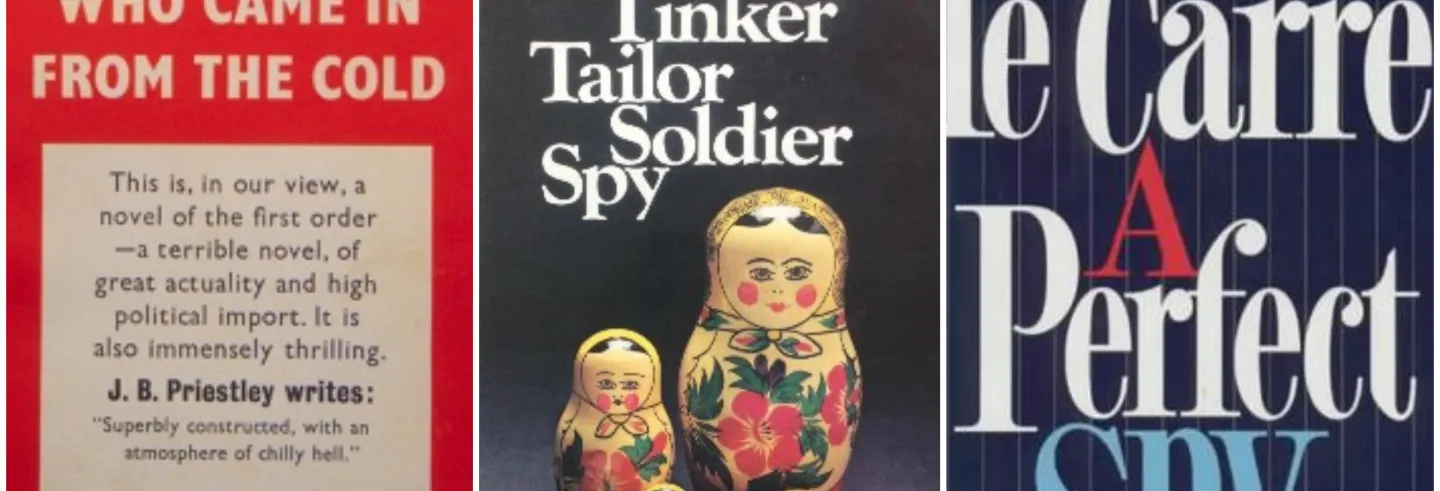The news of John le Carrè’s death has left me bereft. I feel as if I have lost a dear friend who enriched my life. Though, if truth be told, we never met. In the 1990s we corresponded briefly. But some of his books, especially, Tinker Tailor Soldier Spy, The Honourable Schoolboy, Smiley’s People, The Spy Who came in from the Cold, and his two first books (A Murder of Quality and Call for the Dead) were my constant gardeners watering large acres of my mental landscape. He did not know it, but le Carrè’s literary oeuvre was a significant presence in my life. I am certain that this is true for others as well.
The chronological contours of his life, thanks to Adam Sisman’s detailed biography (John le Carrè: The Biography) are fairly well known. He was born David Cornwell to Ronnie and Olive Cornwell. Ronnie was a con man and an occasional jailbird; Olive unable to take Ronnie’s serial unscrupulous acts left him and her sons one night. David was then only five years old. This childhood experience never left David. He was to write later, "People who have had very unhappy childhoods are pretty good at inventing themselves." David Cornwell wore many masks of which John le Carrè—his nom de plume—was the most famous. David Cornwell, as le Carrè, could never exorcize the ghost of his father in spite of devoting a full novel—A Perfect Spy—to him. Cornwell-le Carrè, as the quotation that serves as an epigraph to this piece, saw himself as the bridge across which his descendants had to walk to move from illusion to reality.
The third novel that le Carrè wrote, 'The Spy Who Came In From the Cold', registered indelibly the arrival of an outstanding writer.
He went to the public school Sherborne in Dorset from which he fled to Bern in Switzerland. This was a bid for freedom, from England to continental Europe. He returned to take a First in Modern Languages from Lincoln College, Oxford. He taught at Eton, a school for which he expressed his deep loathing. From Eton, he joined the British Secret Service (he was already passing on bits of information to the secret service while he was at Oxford), working first for the MI5 and then for MI6. Within the secret service, he secretly pursued his muse to be a writer and created his most unforgettable character George Smiley (about whom more later). Only the very discerning saw in the first two books, the emergence of a major literary talent. The third novel that le Carrè wrote, The Spy Who Came In from the Cold, registered indelibly the arrival of an outstanding writer.
That novel in terms of its plot and its prose continues to haunt. No novel, before or since, evoked the Cold War landscape so memorably. Consider the following, spare and austere, from the opening chapter:
Pushing up the collar of his jacket, Leamas stepped outside into the icy October wind. He remembered the crowd then. It was something you forgot inside the hut, this group of puzzled faces. The people changed but the expressions were the same.Smoke or dust rose through the beam of the arclamps, a constant shifting pall between the margins of light.There was only one light in the checkpoint, a reading lamp with a green shade, but the glow of arclights,like artificial moonlight, filled the cabin. Darkness had fallen and with it silence.Leamas went to the window and waited. In front of him the road and to either side the Wall, a dirty, ugly thing of breeze blocks and strands of barbed wire, lit with cheap yellow light, like the backdrop of a concentration camp. East and west of the Wall lay the unrestored part of Berlin,a half-world of ruin, drawn in two dimensions,crags of war.
The plot was no less compelling: the cynical idea of sending in an agent behind the Iron Curtain without actually informing him about the real target. Alec Leamas pretends to be a disgruntled Circus agent who is willing to turn double to bring down Hans-dieter Mundt, the head of the East German secret service. He is unaware that Mundt had already been recruited by the British secret service. The real target is Josef Fiedler, Mundt’s deputy, who suspects Mundt and is close to exposing him. Thinking inside out, Control, the head of the Circus, prepares documents and evidence implicating Mundt. Fiedler befriends Leamas who gives him all the manufactured information regarding Mundt. In the penultimate sequence, Mundt with information supplied to him by Control and perhaps Smiley exposes Leamas for what he truly is, a British agent. Fiedler is charged with treason. Mundt arranges for Leamas, who is horrified by the diabolical nature of the plot, to escape but has him shot at the Wall. It was the telling of this convoluted plot that made it credible. Le Carrè also suggested that in the Cold War, the champions of freedom were no less ruthless than those who suppressed liberty. He has Control say: "I mean, you can’t be less ruthless than the opposition simply because your government’s policy is benevolent, can you now?" This was a theme to which he would return.
George Smiley makes cameo appearances in The Spy Who Came In from the Cold. But to those who read the le Carrè novels in sequence of publication, he is a familiar figure. He is introduced in the very first chapter of le Carrè’s debut novel, Call for the Dead. That chapter called, "A Brief History of George Smiley’’, in terms of sheer style, represents le Carrè at his best. Smiley married to the exquisitely beautiful, Lady Ann Sercomb, is described by her to her Mayfair friends as "breathtakingly ordinary". Smiley is "Short, fat, and of a quiet disposition, he appeared to spend a lot of money on really bad clothes, which hung about his squat frame like skin on a shrunken toad." He had been to an unimpressive school and from there had "lumbered blinking into the murky cloisters of his unimpressive Oxford College" dreaming of fellowships. As a student he was good enough to secure an offer from All Souls but his tutor, Jebedee gently guided him to join the Secret Service. When we meet him for the first time, he is a full-fledged intelligence officer and divorced from Ann. If le Carrè failed to exorcize the spectre of his father, Smiley failed to free himself of Ann: "though Lady Ann just ran away, a little bit of George Smiley had indeed died." She keeps resurfacing at crucial points in his life.
As a lapsed academic turned intelligence officer, Smiley came to love "academic excursions into the mystery of human behaviour, disciplined by the practical applications of his own deductions. By the strength of his intellect, he forced himself to observe humanity with clinical objectivity, and because he was neither immortal nor infallible, he hated and feared the falseness of his life." The italics are mine because even as le Carrè introduces Smiley he draws attention—without making too heavy a point of it—to the moral ambiguity that will emerge as a central trait of Smiley’s character.
After the first two novels—and a brief appearance in The Looking Glass War—Smiley disappears only to reappear as the protagonist in Tinker Tailor Soldier Spy, The Honourable Schoolboy, and Smiley’s People—The Quest for Karla trilogy. In the first and the last of these novels, Smiley is called back from retirement and in The Honourable Schoolboy is the head of the Circus, a broken and utterly demoralized organization after Smiley had smoked out the mole that Karla—head of the Soviet secret service—had planted in the Circus. In Smiley’s People, Karla is coerced to defect by Smiley.
The moral self-deception that Control had spoken about and the cynical premise that the end justifies the means are integral parts of Smiley’s world to which he belongs but with which he is perpetually out of tune. This creates the space for his moral ambiguity. In Tinker Tailor, Bill Haydon, the Circus mole, can set up an operation knowing full well that in the course of it his best friend and lover, Jim Prideaux, could be shot and could even die. It is this act of betrayal and the fact that as insurance Bill had trailed an affair with Ann that so appalls Smiley. But he is unable, from his heart, to hate Haydon. When he discovers that Haydon is the mole, Smiley is driven "to the rocks of despair and then to mutiny"; le Carrè makes Smiley reflect thus:
I refuse. Nothing is worth the destruction of another human being. Somewhere the path of pain and betrayal must end. Until that happened there was no future: there was only a continued slide into still more terrifying versions of the present. This man was my friend and Ann’s lover, Jim’s friend and for all I know Jim’s lover too; it was the treason, not the man, that belonged to the public domain. Haydon had betrayed. As a lover, a colleague, a friend; as a patriot, as a member of that inestimable body which Ann loosely called the Set: in every capacity Haydon had overtly pursued one aim and secretly achieved its opposite; yet there was a part of him that rose already in Haydon’s defence. Was not Bill also betrayed? Connie’s lament rang in his ears: 'Poor loves. Trained to Empire, trained to rule the waves...You’re the last George, you and Bill.' He saw with painful clarity an ambitious man born to the big canvas, brought up to rule, divide and conquer, whose visions and vanities were all fixed upon the world’s game; for whom the reality was a poor island with scarcely a voice that would carry across the water. Thus Smiley felt not only disgust; but despite all that the moment meant to him, a surge of resentment against the institutions he was supposed to be protecting—why should anyone be loyal to them?
In The Honourable Schoolboy, having done all the research and the leg work to unearth another Karla mole in Hong Kong, Smiley is the victim of a squalid conspiracy hatched by his own side. Recognizing this, Smiley writes to Ann,
So far as I can remember of my youth, I chose the secret road because it seemed to lead straightest and furthest toward my country’s goal. The enemy in those days was someone we could point at and read about in the papers. Today, all I know is that I have learned to interpret the whole of life in terms of conspiracy. That is the sword I have lived by, and as I look round me now I see it is the sword I shall die by as well. These people terrify me, but I am one of them. If they stab me in the back, then at least that is the judgment of my peers.
He is poised to realize the moral vacuity of it all. In Smiley’s People, at the very moment of his triumph when he has successfully compelled Karla to defect, Smiley’s moral ambiguity acquires a heightened intensity. The desolate Cold War landscape of Berlin that Leamas had surveyed is revived at the end of Smiley’s People except that the location this time is Glienicke Bridge, the only water crossing between the East and the West. Le Carrè writes,
Smiley crouched to the rifle slit, the skirts of his tweed coat trailing in the mud, while he surveyed the scene before him as if it held the very reaches of his own long life. The river was broad and slow, misted with cold. Arc lights played over it, and the snow danced in their beams... [on the river] the only ship was a grey patrol boat moored at the Eastern bank, and the only commerce it offered was death. From his vantage point, Smiley could scan the whole length of it with his field-glasses, from the flood-lit white barrack house on its Eastern bank, up to the black sentry tower at the crest, then slightly downhill again towards the Western side: to the cattle pen, the pillbox that controlled the gateway, and finally the halo.
On the bridge, he saw, "One small man, in a worker’s half-length coat, with a worker’s satchel slung across his little chest, walking…to cut himself off from the black castle behind him."
As Smiley saw this,
an unholy vertigo seized him as the very evil he had fought against seemed to reach out and possess him and claim him despite his striving, calling him a traitor also; mocking him, yet at the same time applauding his betrayal. On Karla had descended the curse of Smiley’s compassion; on Smiley the curse of Karla’s fanaticism. I have destroyed him with the weapons I abhorred, and they are his. We have crossed each other’s frontiers, we are the no-men of this no-man’s land.
Triumph is shot through the poignancy of tragedy.
In Smiley’s personal life, Ann stands as the metaphor of his troubled ambiguity. Ann, as Smiley saw her at the end of Tinker Tailor, "tall and puckish, extraordinarily beautiful, essentially another man’s woman."
Le Carrè also uses buildings of an England that has disappeared to reflect the moral desolation. The Circus housed in a ramshackle building in Cambridge Circus with its creaking lift, grimy corridors and notice boards with outdated notices. Sarrat was,
...a sorry place after the grandeur which Smiley remembered. Most of the elms had gone with the disease; pylons burgeoned over the old cricket field. The house itself, a sprawling brick mansion, had also come down a lot since the heyday of the cold war in Europe and most of the better furniture seemed to have disappeared.
And the house in which Ann had spent her childhood,
The house stood on a hill, in a coppice of bare elms still waiting for the blight. It was granite and very big, and crumbling, with a crowd of gables that clustered like torn black tents above the tree tops. Acres of smashed greenhouses led to it; collapsed stables and an untended kitchen garden lay below it in the valley.
It would be unfair to leave George Smiley without mentioning some adorable characters that le Carrè creates to inhabit Smiley’s world—Connie Sachs, Jim Prideaux, Jerry Westerby, Peter Guillam, Craw and Mendel. Around such people, le Carrè created a self-contained universe, complete with its own language and terms—scalphunters, lamplighters, Moscow Rules, Lace Curtian, mole and so on. It was le Carrè’s genius that made this world credible. The Secret Pilgrim, a much-neglected book in the corpus of le Carrè’s writings, is in many ways a Smiley novel since he appears in it as an after-dinner speaker and his speech evokes in Ned (the narrator and former member of the Circus, a Smiley protégé) his own troubled moral dilemmas.
The end of the Cold War removed le Carrè’s moral ambiguities and left him free to write passionately against the corruption of arms dealers and their links with politicians and members of the higher echelons of the secret service; against big pharma companies and their exploitation of the poor in Africa; against the mindless violence that engulfs Palestine and Israel; against the fabrication of intelligence; against the ruthlessness of the Russian mafia; and finally against Trump and Brexit. Le Carrè explored and exposed these with a terrifying clarity and a terrible beauty was born through his later novels.
John le Carrè chronicled in his Cold War novels the desolation, the hypocrisy and the moral complacency of our times but he also flew out of his own pigeon tunnel to present a nobler world...
Against this frightening world, le Carrè situated certain noble and good individuals aspiring to love and survive with compassion. Think of Barley Blair in The Russia House waiting in Lisbon for the ship that will bring to port his love, Katya from Leningrad. Think of Joseph and Charlie at the end of A Little Drummer Girl walking hand in hand in the rain in a strange town in the Midlands trying to forget and escape their past laced with blood. Think of Jonathan Pine (aka Jack Linden) and Jed, in The Night Manager, trying to live anonymously in the West Country after having been freed from the clutches of the world’s most evil man. Love is a covert but significant theme in le Carrè’s novels. For Smiley, "hatred was really not an emotion he could sustain for any length of time, unless it was the obverse side of love." Karla had seen this in Smiley and had told Haydon that Ann was the last illusion of the illusionless man.
Illusion? Is that le Carrè’s name for love? The later novels, less cynical and informed by a loftier vision, would suggest a negative answer to the question.
John le Carrè chronicled in his Cold War novels the desolation, the hypocrisy and the moral complacency of our times but he also flew out of his own pigeon tunnel to present a nobler world liberated from greed and informed by love and compassion. He himself came in from the cold of spying to the warmth of real life and human contact. He was not just a bridge for his own children and grandchildren. John le Carrè humanized his readers.










